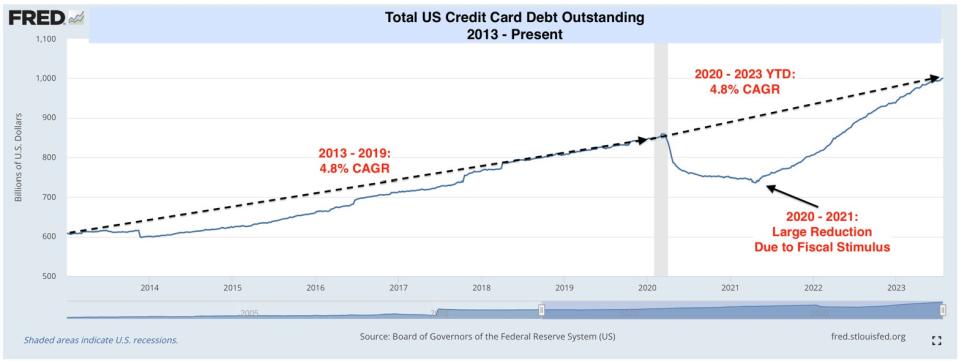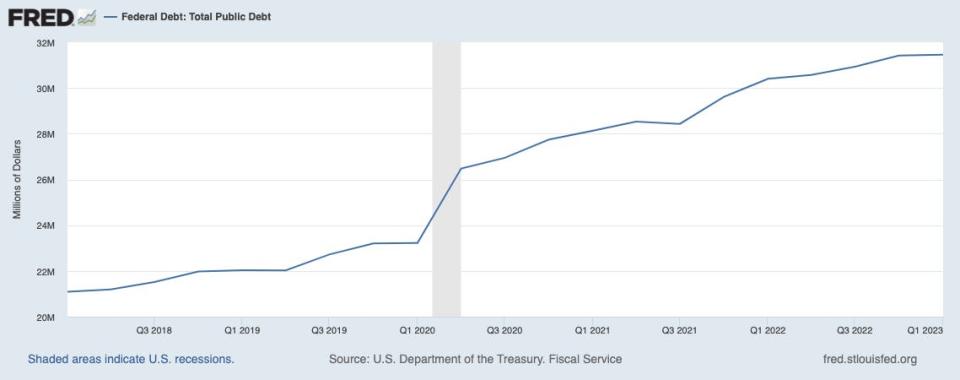[ad_1]

-
There’s a storm of private and public debt troubles that’s headed for the market.
-
Warning signs have sprung up in rising credit card balances, delinquencies, and other indicators.
-
Here are the signs that the US is dealing with troubles stemming from its mountain of debt.
A storm of public and private debt is brewing in the US – and the troubles are already beginning to show on the surface as loans pile up and borrower confidence falters.
At a broad level, Fitch Ratings’ downgrade of the US credit rating and Moody’s downgrade of 10 US banks this summer points to issues for both US sovereign credit (political polarization hampering the US’s ability to meet debt obligations) and debt originated out of the banking sector (structural pressures stemming from tighter credit conditions and Fed policy).
But there are more granular problems mounting across debt markets as well, as both private and public sectors face a drastically different environment than they did in the previous decade when interest rates were at historic lows coming out of the 2008 crisis. If low rates spurred the sugar rush of heavy borrowing, rising interest rates may be setting the stage for the sugar crash.
This was on full display earlier this year as Silicon Valley Bank imploded, driven by mismanagement of its balance sheet which was weighed down by a bond portfolio that was rapidly depreciating as interest rates climbed. SVB, Signature Bank, and First Republic all fell in quick succession.
The fallout from that event was relatively contained, but that hasn’t stopped market pundits and investing icons from sounding the alarm on high debt levels in the era of rising rates. Hedge fund legend Ray Dalio and top economist Nouriel Roubini are among those who have warned a full-blown debt crisis could be on the way.
Here are five charts that point to the warning signs flashing in US debt markets.
1. Private debt levels are rising at a staggering pace
Private debt levels are building fast, and hit new records this year. Credit card debt just passed $1 trillion for the first time ever, according to Federal Reserve data.

Personal unsecured loans also hit a new record, notching an unprecedented $225 billion in 2023, according to TransUnion. Ditto for corporate debt, which saw volumes grow 6.2% over the last year to hit $7.8 trillion, per Janus Henderson.
The public debt picture looks even worse. The national debt balance blew past $32 trillion for first time this year, with the potential for $5 billion to be added each day for the next 10 years, according to Bank of America.

2. Corporate defaults are surging
Companies have begun to buckle under their debt burdens as rates rise, with the volume of defaults among US companies in 2023 already surpassing last year’s total. 55 US firms defaulted on their debt in the first six months of the year – a 53% increase from the 36 companies that defaulted in 2022, Moody’s Investors Service data shows.
Up to $1 trillion of corporate debt could default if the US faces a full-blown recession, Bank of America strategists warned, though the bank no longer sees a recession as likely in 2023.
3. Late payments are piling up
People and companies are increasingly falling behind on their loan payments.
In the commercial real estate sector, the percentage of commercial property owners that were late on payment for 30 days or more–or have already defaulted on their mortgages–rose to 3% in the first quarter this year, according to data from the Mortgage Bankers Association, reversing a preexisting downward trend. This is reflected in the rising rate of delinquencies on loans securing commercial mortgage bonds, which have been on the rise this year.

Meanwhile, the delinquency rate for all personal loans rose to 2.23% in the first quarter this year, up from just 1.7% in the first quarter of 2021, Fed data shows.

4. Banks want to dump risky debt
Banks are already trying to dump loans that have a greater risk of default, even if it means selling those assets at a discount. JPMorgan, Goldman Sachs, and Capital One are among those on Wall Street who are trying to get rid of large commercial real estate assets, Bloomberg reported this week.
Banks are also pulling back on debt-dealing altogether as financial conditions tighten. That spells trouble for the commercial real estate industry, as there’s around $1.5 trillion of CRE debt that’s set to reach maturity in the coming years, and will need to be refinanced.
Property owners could run into trouble when they go to refinance their mortgages as rates are higher and property valuations have been falling. A wave of commercial mortgage defaults could be on the horizon, according to some veteran investors, and banks have already started to rein in lending activity after the spasm of bank failures earlier this year sparked a brief banking crisis.
Earlier this year, Morgan Stanley noted that the credit crunch had arrived as banks recorded the sharpest decline in lending on record.

Read the original article on Business Insider
[ad_2]
Source link
